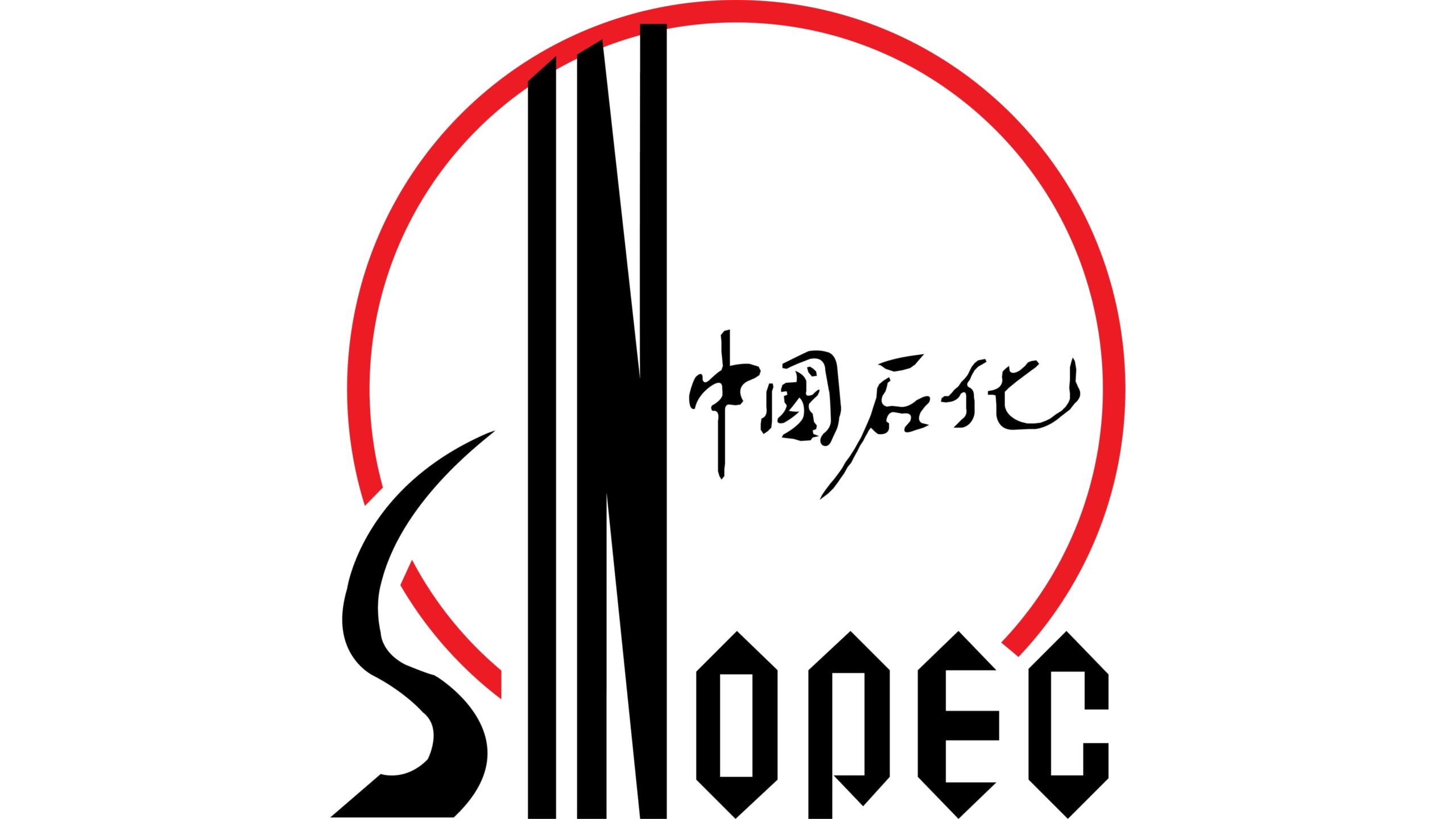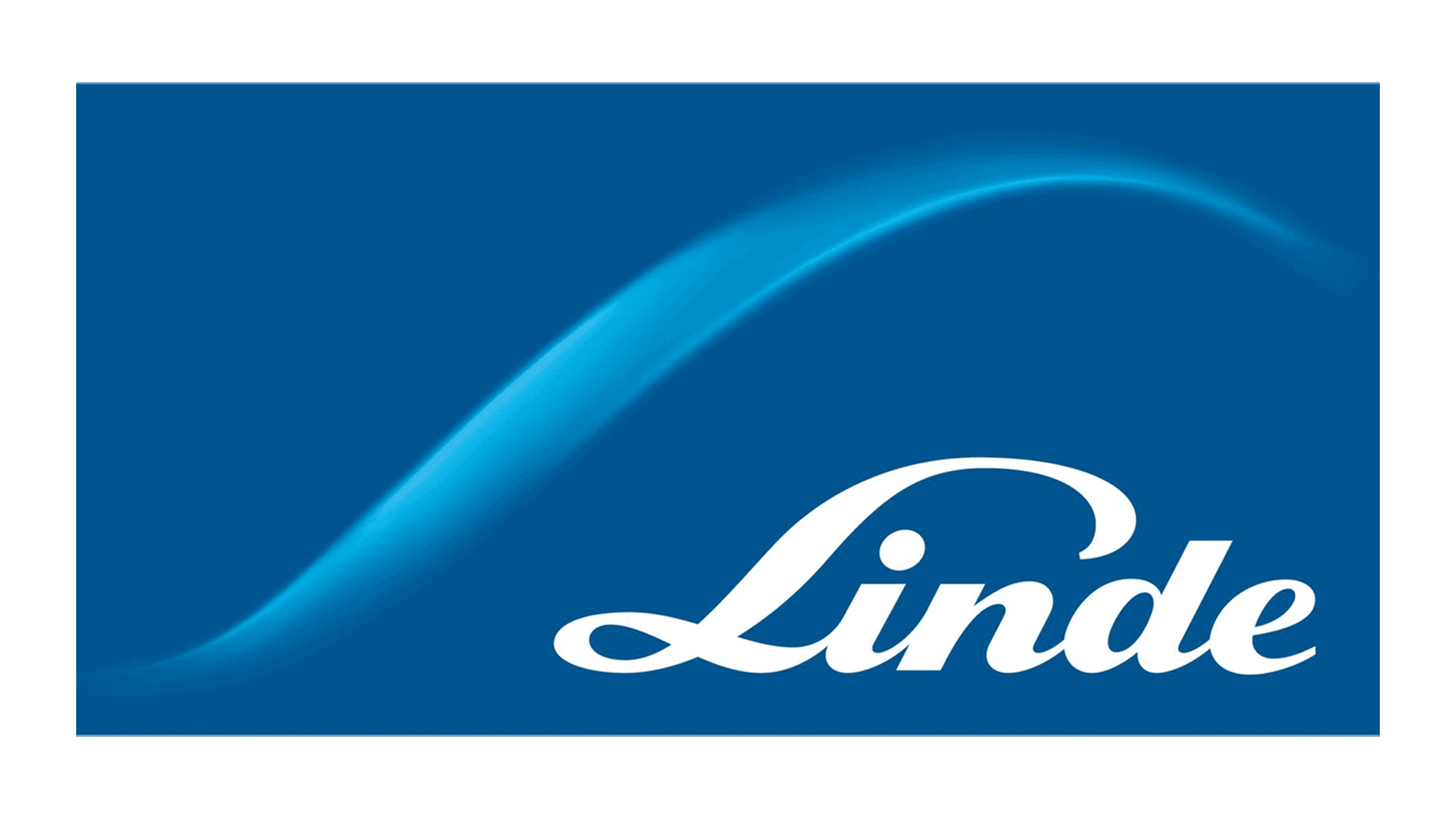Global Folding Boxboard Market Insights, Growth, Share, Size: By Weight, By Material Type, By Distribution Channel, By End User Industry, By Region & Segmental Forecast, 2024 – 2034, Comparative Analysis and Trends
- Industry: Chemicals & Materials
- Report ID: TNR-110-1067
- Number of Pages: 420
- Table/Charts : Yes
- April, 2024
- Base Year : 2024
- No. of Companies : 10+
- No. of Countries : 29
- Views : 10165
- Covid Impact Covered: Yes
- War Impact Covered: Yes
- Formats : PDF, Excel, PPT
Global Folding Boxboard Market was Valued at US$ 14.3 Bn in 2023, With an Estimated CAGR of 6.04% During 2024 – 2034
Folding boxboard is a type of paperboard specifically designed for packaging applications. It’s a versatile material commonly used for creating various types of folding cartons and boxes, particularly in the food, beverage, cosmetic, and pharmaceutical industries. This material typically consists of multiple layers of paperboard, often with different properties, laminated together to achieve the desired strength, stiffness, and printability. The outer layers are usually made from higher-quality paperboard to provide a smooth surface for printing, while the inner layers are made from recycled paperboard to enhance cost-effectiveness and sustainability.
Folding boxboard is known for its ability to be easily folded and creased without cracking, making it ideal for creating intricate packaging designs. It can also be coated with various finishes such as matte or glossy coatings to enhance its visual appeal and provide additional protection against moisture and other environmental factors.
Global Folding Boxboard Market Revenue & Forecast, (US$ Million), 2016 – 2034
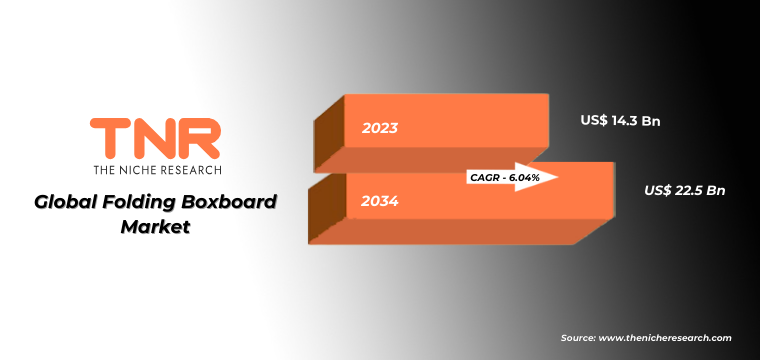
Sustainability and Environmental Concerns are Significant Driving Forces: Global Folding Boxboard Market
Increased environmental awareness among consumers has led to a growing demand for sustainable and recyclable packaging options. Consumers are more conscious of the environmental impact of their choices and prefer products with eco-friendly packaging, including folding boxboard. Stringent environmental regulations and policies across countries promote sustainability in packaging materials. Manufacturers in the folding boxboard market are compelled to comply with or exceed these regulations, encouraging the use of materials that are recyclable, biodegradable, and sourced responsibly. Additionally, many companies prioritize sustainability as a part of their corporate social responsibility initiatives. Utilizing folding boxboard aligns with these initiatives, allowing companies to demonstrate their commitment to environmental stewardship.
Competition From Alternative Materials is a Significant Restraint Affecting the Global Folding Boxboard Market Demand
Plastics, including flexible packaging materials, offer lightweight, durable, and cost-effective alternatives to folding boxboard. These materials are often chosen for their versatility in packaging various products and their barrier properties against moisture and external elements. Similarly, flexible films and pouches offer a lightweight and flexible packaging option that is gaining popularity, especially in industries where convenience and portability are crucial.
These materials compete with folding boxboard for certain types of packaging requirements. While folding boxboard is often chosen for its recyclability and sustainability, alternative materials are continually evolving to address environmental concerns. Developments in biodegradable plastics and other eco-friendly alternatives contribute to competition in the context of changing regulations and consumer preferences. Additionally, Ongoing technological advancements in alternative materials, such as improved barrier coatings for plastics, can make them more attractive for specific packaging needs, intensifying competition with folding boxboard.
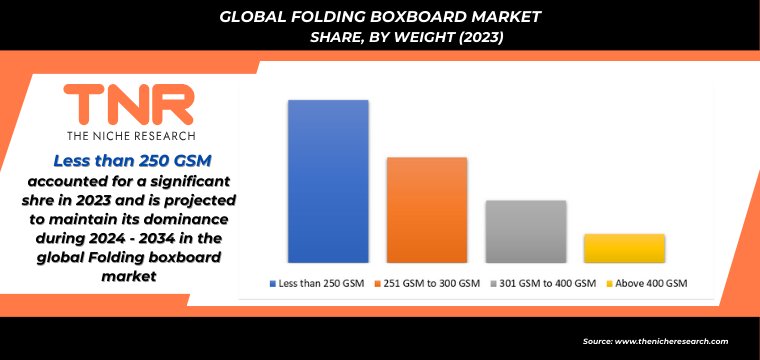
Less than 250 GSM accounted for highest market share in 2023 and is expected to maintain its dominance throughout the forecast period (2024 – 2034) in the global folding boxboard market. Firstly, it’s more cost-effective compared to heavier weight options, making it an attractive choice for manufacturers aiming to optimize packaging costs. Secondly, its versatility allows for various packaging purposes across industries like food and beverage, cosmetics, pharmaceuticals, and consumer goods. Thirdly, with the increasing emphasis on sustainability, lighter weight folding boxboard aligns well with eco-friendly packaging initiatives, often utilizing recycled materials and requiring fewer resources for production.
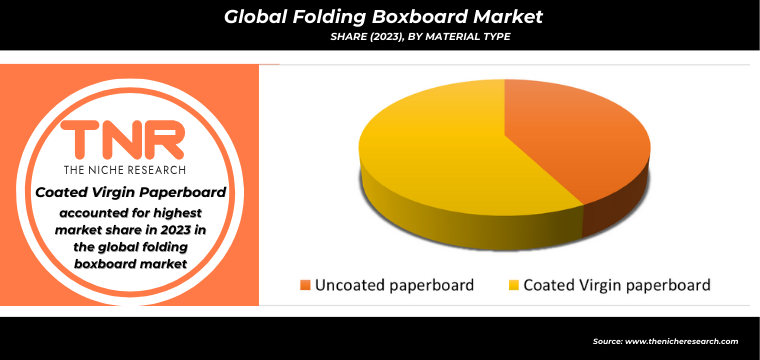
The dominance of coated virgin paperboard in the global folding boxboard market underscores a significant trend favored by numerous packaging manufacturers and brand owners.
Renowned for its premium quality and superior surface finish, coated virgin paperboard stands as a preferred choice across diverse industries. For instance, companies like Tetra Pak, a leader in sustainable packaging solutions, extensively utilize coated virgin paperboard in their carton packaging for beverages. Tetra Pak’s packaging for milk, juices, and other liquid products exemplifies the exceptional print quality and barrier properties offered by coated virgin paperboard, ensuring product freshness and visual appeal on retail shelves.
Similarly, in the cosmetics industry, luxury brands such as Chanel and Estée Lauder opt for coated virgin paperboard for their high-end product packaging. The smooth surface of the paperboard allows for intricate printing designs and branding elements, elevating the perceived value of the products. Similarly, pharmaceutical companies like Pfizer and GlaxoSmithKline rely on coated virgin paperboard for their medicine packaging, ensuring product integrity and compliance with regulatory standards. The strength, durability, and enhanced barrier properties of coated virgin paperboard make it indispensable for protecting sensitive pharmaceutical products from external factors.
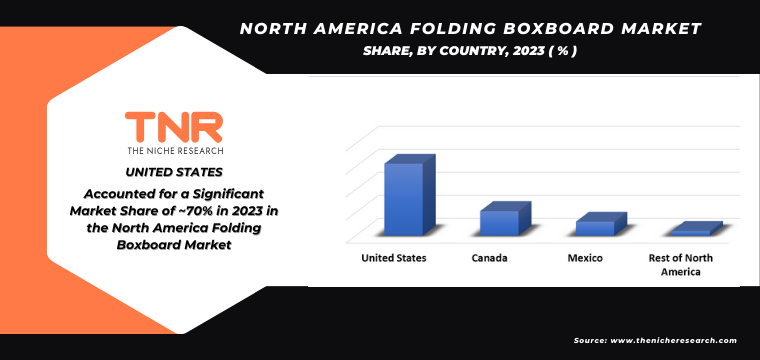
North America’s dominance in 2023 in the folding boxboard market is a testament to its robust packaging industry and strong market presence. With industry giants like International Paper, WestRock, and Georgia-Pacific leading the way, the region commands a significant share of the global folding boxboard market. North America benefits from a thriving economy and a substantial consumer base with considerable purchasing power, driving demand for packaged goods across various sectors. Additionally, the region boasts advanced packaging infrastructure, including cutting-edge manufacturing facilities and distribution networks, enabling efficient production and distribution of folding boxboard products. Stringent regulatory standards, particularly in industries like food and pharmaceuticals, further reinforce the preference for folding boxboard due to its compliance with safety and quality regulations.
Moreover, North American companies are at the forefront of innovation and sustainability initiatives in the packaging industry, driving the adoption of eco-friendly materials like folding boxboard made from sustainable sources and recyclable materials. Finally, the region’s diverse consumer preferences necessitate versatile packaging solutions, with folding boxboard offering customization options in design, printing capabilities, and functionality to meet varied market demands. With these factors at play, North America is poised to maintain its leading position in the global folding boxboard market for the foreseeable future.
Competitive Landscape: Global Folding Boxboard Market
The competitive landscape of the global folding boxboard market is characterized by the presence of several key players competing for market share and driving innovation. These companies compete based on product quality, innovation, sustainability, and customer service. They offer a diverse range of folding boxboard products catering to various industries, leveraging their expertise and technological advancements to maintain a competitive edge. The folding boxboard market is characterized by a focus on sustainability, efficiency, and meeting evolving customer needs worldwide. A few of the key players in the global folding boxboard market are listed below:
- Holmen
- International Paper
- ITC LIMITED
- Klabin
- Metsä Board
- MM BOARD & PAPER
- Mondi Group
- Nippon Paper Industries Co., Ltd.
- Oji Holdings Corporation
- Pactiv Evergreen Inc.
- Sappi
- Smurfit Kappa Group
- Stora Enso
- WestRock Company
- Other Market Participants
Global Folding Boxboard Market Summary
| Report Specifications | Details |
| Market Revenue in 2023 | US$ 14.3 Bn |
| Market Size Forecast by 2034 | US$ 22.5 Bn |
| Growth Rate (CAGR) | 6.04% |
| Historic Data | 2016 – 2022 |
| Base Year for Estimation | 2023 |
| Forecast Period | 2024 – 2034 |
| Report Inclusions | Market Size & Estimates, Market Dynamics, Competitive Scenario, Trends, Growth Factors, Market Determinants, Key Investment Segmentation, Product/Service/Solutions Benchmarking |
| Segments Covered | By Weight, By Material Type, By Distribution Channel, By End User Industry |
| Regions Covered | North America, Europe, Asia Pacific, Middle East & Africa, Latin America |
| Countries Covered | U.S., Canada, Mexico, Rest of North America, France, The UK, Spain, Germany, Italy, Nordic Countries (Denmark, Finland, Iceland, Sweden, Norway), Benelux Union (Belgium, The Netherlands, Luxembourg), Rest of Europe, China, Japan, India, New Zealand, Australia, South Korea, Southeast Asia (Indonesia, Thailand, Malaysia, Singapore, Rest of Southeast Asia), Rest of Asia Pacific, Saudi Arabia, UAE, Egypt, Kuwait, South Africa, Rest of Middle East & Africa, Brazil, Argentina, Rest of Latin America |
| Key Players | Holmen, International Paper, ITC LIMITED, Klabin, Metsä Board, MM BOARD & PAPER, Mondi Group, Nippon Paper Industries Co., Ltd., Oji Holdings Corporation, Pactiv Evergreen Inc., Sappi, Smurfit Kappa Group, Stora Enso, WestRock Company, Other Market Participants |
| Customization Scope | Customization allows for the inclusion/modification of content pertaining to geographical regions, countries, and specific market segments. |
| Pricing & Procurement Options | Explore purchase options tailored to your specific research requirements |
| Contact Details | Consult With Our Expert
Japan (Toll-Free): +81 663-386-8111 South Korea (Toll-Free): +82-808- 703-126 Saudi Arabia (Toll-Free): +966 800-850-1643 United Kingdom: +44 753-710-5080 United States: +1 302-232-5106 E-mail: askanexpert@thenicheresearch.com
|
Global Folding Boxboard Market Scope
By Weight
- Less than 250 GSM
- 251 GSM to 300 GSM
- 301 GSM to 400 GSM
- Above 400 GSM
By Material Type
- Uncoated paperboard
- UC1
- UC2
- Coated Virgin paperboard
- GC1
- GC2
By Distribution Channel
- Online
- Offline
By End User Industry
- Food and Beverages
- Frozen Foods
- Snacks and Cereals
- Fruits and Vegetables
- Premium Beverages and Liquor
- Confectionary
- Dairy Products
- Others
- Pharmaceutical
- Consumer Goods
- Personal Care and Cosmetics
- Apparel
- Consumer Electronics
- Automotive
- Manufacturing
- Textiles
- Logistics
- E-commerce and retail
- Others
By Region
- North America (U.S., Canada, Mexico, Rest of North America)
- Europe (France, The UK, Spain, Germany, Italy, Nordic Countries (Denmark, Finland, Iceland, Sweden, Norway), Benelux Union (Belgium, The Netherlands, Luxembourg), Rest of Europe)
- Asia Pacific (China, Japan, India, New Zealand, Australia, South Korea, Southeast Asia (Indonesia, Thailand, Malaysia, Singapore, Rest of Southeast Asia), Rest of Asia Pacific)
- Middle East & Africa (Saudi Arabia, UAE, Egypt, Kuwait, South Africa, Rest of Middle East & Africa)
- Latin America (Brazil, Argentina, Rest of Latin America)
Report Coverage
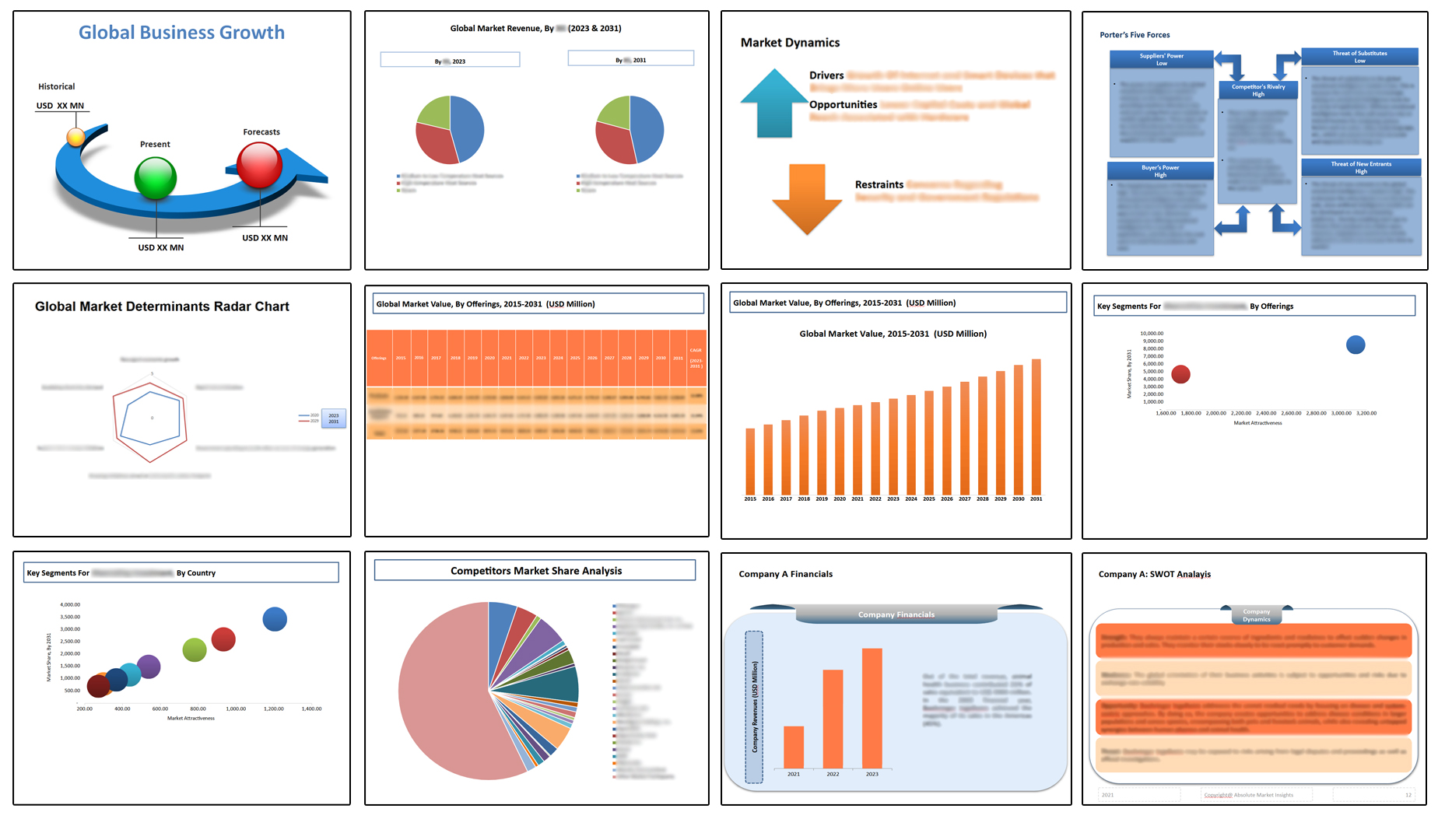
Table of Contents
**Exclusive for Multi-User and Enterprise User.
Global Folding Boxboard Market
By Weight
- Less than 250 GSM
- 251 GSM to 300 GSM
- 301 GSM to 400 GSM
- Above 400 GSM
By Material Type
- Uncoated paperboard
- UC1
- UC2
- Coated Virgin paperboard
- GC1
- GC2
By Distribution Channel
- Online
- Offline
By End User Industry
- Food and Beverages
- Frozen Foods
- Snacks and Cereals
- Fruits and Vegetables
- Premium Beverages and Liquor
- Confectionary
- Dairy Products
- Others
- Pharmaceutical
- Consumer Goods
- Personal Care and Cosmetics
- Apparel
- Consumer Electronics
- Automotive
- Manufacturing
- Textiles
- Logistics
- E-commerce and retail
- Others
By Region
- North America (U.S., Canada, Mexico, Rest of North America)
- Europe (France, The UK, Spain, Germany, Italy, Nordic Countries (Denmark, Finland, Iceland, Sweden, Norway), Benelux Union (Belgium, The Netherlands, Luxembourg), Rest of Europe)
- Asia Pacific (China, Japan, India, New Zealand, Australia, South Korea, Southeast Asia (Indonesia, Thailand, Malaysia, Singapore, Rest of Southeast Asia), Rest of Asia Pacific)
- Middle East & Africa (Saudi Arabia, UAE, Egypt, Kuwait, South Africa, Rest of Middle East & Africa)
- Latin America (Brazil, Argentina, Rest of Latin America)
The Niche Research approach encompasses both primary and secondary research methods to provide comprehensive insights. While primary research is the cornerstone of our studies, we also incorporate secondary research sources such as company annual reports, premium industry databases, press releases, industry journals, and white papers.
Within our primary research, we actively engage with various industry stakeholders, conducting paid interviews and surveys. Our meticulous analysis extends to every market participant in major countries, allowing us to thoroughly examine their portfolios, calculate market shares, and segment revenues.
Our data collection primarily focuses on individual countries within our research scope, enabling us to estimate regional market sizes. Typically, we employ a bottom-up approach, meticulously tracking trends in different countries. We analyze growth drivers, constraints, technological innovations, and opportunities for each country, ultimately arriving at regional figures.Our process begins by examining the growth prospects of each country. Building upon these insights, we project growth and trends for the entire region. Finally, we utilize our proprietary model to refine estimations and forecasts.
Our data validation standards are integral to ensuring the reliability and accuracy of our research findings. Here’s a breakdown of our data validation processes and the stakeholders we engage with during our primary research:
- Supply Side Analysis: We initiate a supply side analysis by directly contacting market participants, through telephonic interviews and questionnaires containing both open-ended and close-ended questions. We gather information on their portfolios, segment revenues, developments, and growth strategies.
- Demand Side Analysis: To gain insights into adoption trends and consumer preferences, we reach out to target customers and users (non-vendors). This information forms a vital part of the qualitative analysis section of our reports, covering market dynamics, adoption trends, consumer behavior, spending patterns, and other related aspects.
- Consultant Insights: We tap into the expertise of our partner consultants from around the world to obtain their unique viewpoints and perspectives. Their insights contribute to a well-rounded understanding of the markets under investigation.
- In-House Validation: To ensure data accuracy and reliability, we conduct cross-validation of data points and information through our in-house team of consultants and utilize advanced data modeling tools for thorough verification.
The forecasts we provide are based on a comprehensive assessment of various factors, including:
- Market Trends and Past Performance (Last Five Years): We accurately analyze market trends and performance data from preceding five years to identify historical patterns and understand the market’s evolution.
- Historical Performance and Growth of Market Participants: We assess the historical performance and growth trajectories of key market participants. This analysis provides insights into the competitive landscape and individual company strategies.
- Market Determinants Impact Analysis (Next Eight Years): We conduct a rigorous analysis of the factors that are projected to influence the market over the next eight years. This includes assessing both internal and external determinants that can shape market dynamics.
- Drivers and Challenges for the Forecast Period:Identify the factors expected to drive market growth during the forecast period, as well as the challenges that the industry may face. This analysis aids in deriving an accurate growth rate projection.
- New Acquisitions, Collaborations, or Partnerships: We keep a close watch on any new acquisitions, collaborations, or partnerships within the industry. These developments can have a significant impact on market dynamics and competitiveness.
- Macro and Micro Factors Analysis:A thorough examination of both macro-level factors (e.g., economic trends, regulatory changes) and micro-level factors (e.g., technological advancements, consumer preferences) that may influence the market during the forecast period.
- End-User Sentiment Analysis: To understand the market from the end-user perspective, we conduct sentiment analysis. This involves assessing the sentiment, preferences, and feedback of the end-users, which can provide valuable insights into market trends.
- Perspective of Primary Participants: Insights gathered directly from primary research participants play a crucial role in shaping our forecasts. Their perspectives and experiences provide valuable qualitative data.
- Year-on-Year Growth Trend: We utilize a year-on-year growth trend based on historical market growth and expected future trends. This helps in formulating our growth projections, aligning them with the market’s historical performance.
Research process adopted by TNR involves multiple stages, including data collection, validation, quality checks, and presentation. It’s crucial that the data and information we provide add value to your existing market understanding and expertise. We have also established partnerships with business consulting, research, and survey organizations across regions and globally to collaborate on regional analysis and data validation, ensuring the highest level of accuracy and reliability in our reports.


